Takoyaki, or Grilled Octopus Balls, originated in Osaka and are one of Japan’s best-known street foods. Whether you make a traditional style with bits of octopus or choose creative alternatives, these ball-shaped dumplings are fun to make with your friends and family!
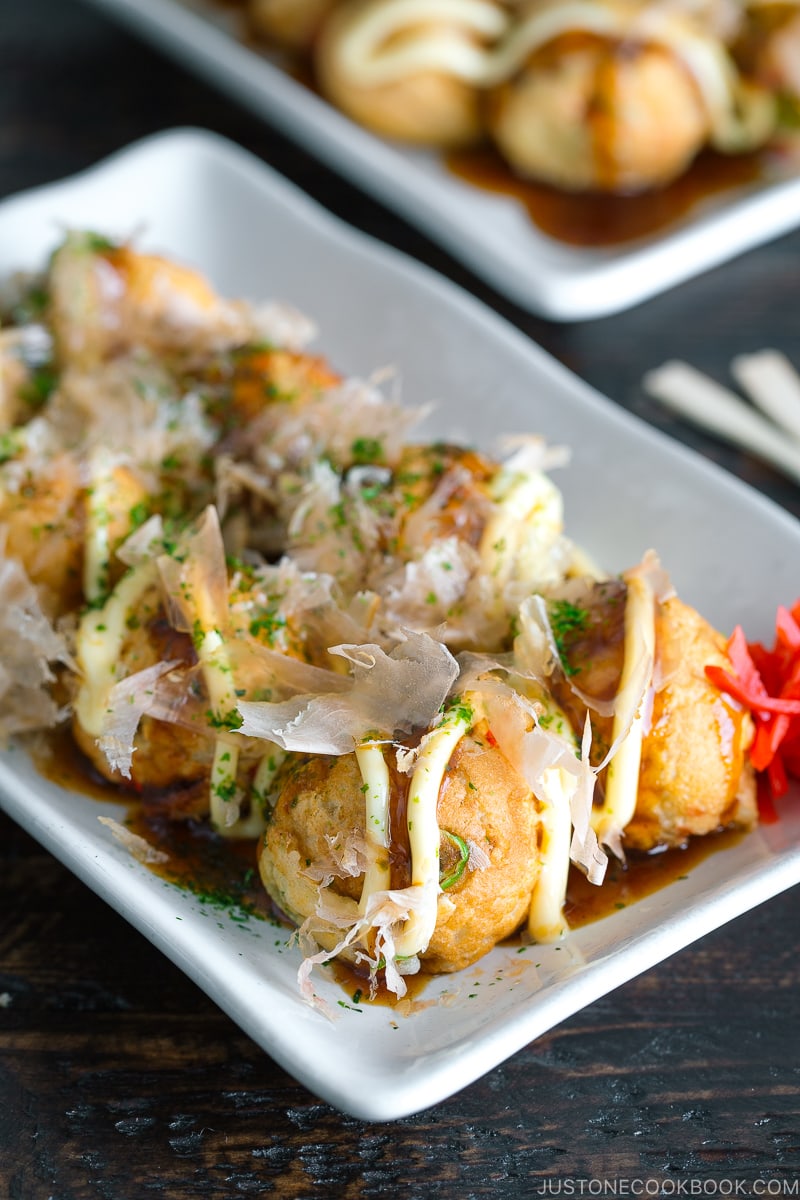
Takoyaki (たこ焼き) is a Japanese snack in the shape of little round balls containing pieces of octopus. Tako-yaki literally translates to “octopus-grilled/fried” and some people may call it “Grilled Octopus Balls” or “Octopus Dumplings”.
What is Takoyaki
Here are some facts about takoyaki.

- It originated and became popular in Osaka around 1935 (according to wiki) and then spread to greater south-central Japan and beyond.
- It’s one of the most popular Japanese street foods along with Okonomiyaki.
- Takoyaki is usually sold by street vendors, convenience stores, supermarkets, food courts, and of course specialty restaurants. In Osaka, takoyaki stands can be easily found throughout the city.
- It is usually served with slightly salty takoyaki sauce, which goes well with beer and other alcoholic drinks. Therefore, many Izakaya restaurants serve takoyaki on the menu.
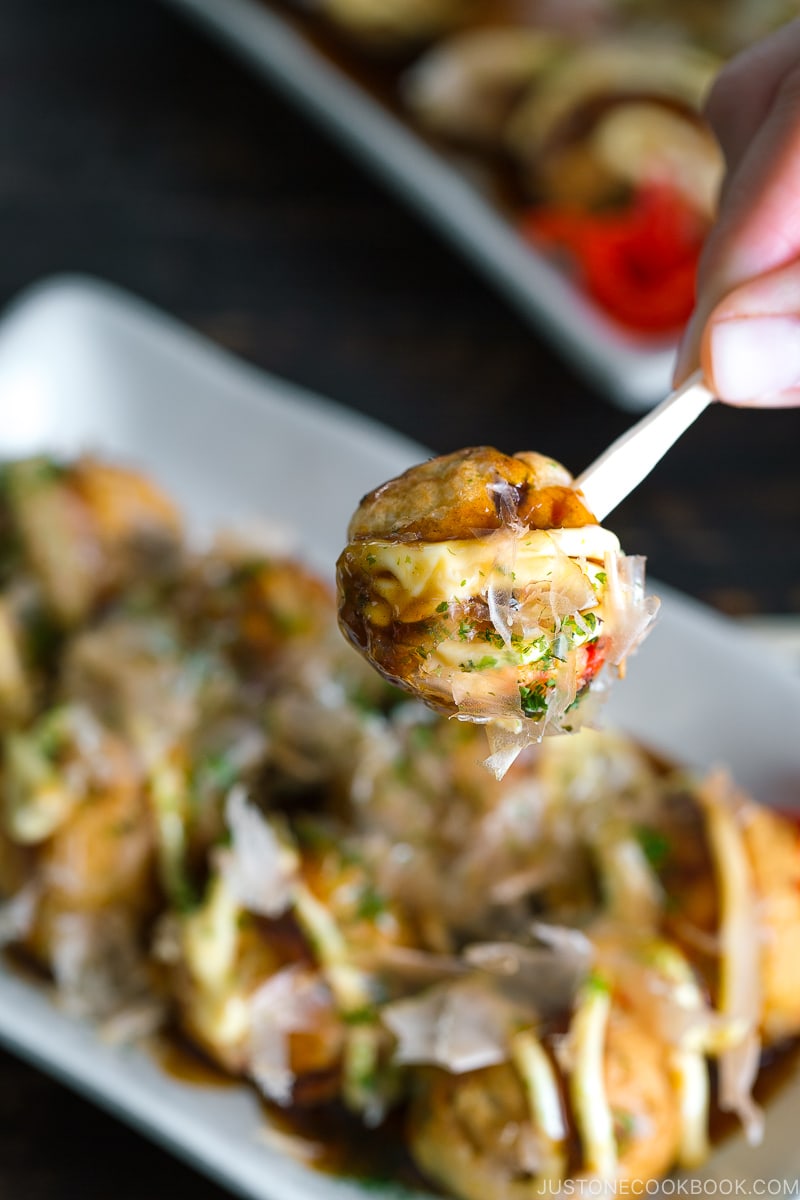
5 Ingredients for Authentic Takoyaki
There are so many variations of takoyaki throughout Japan. For example, the original Osaka-style does not include any cabbage, but many regional variations (Kyoto, Kobe, Nagoya, Tokyo areas) do. Even though I lived in the Tokyo area, I actually didn’t know they sometimes contain cabbage till now.
Here are the ingredients for the classic takoyaki recipe.
1. Dashi-flavored batter
Very simple. It’s a mixture of Japanese stock Dashi, all-purpose flour, baking powder, eggs, salt, and soy sauce. If you don’t want to make the batter from scratch, you can find takoyaki mix in Japanese grocery stores or Amazon.
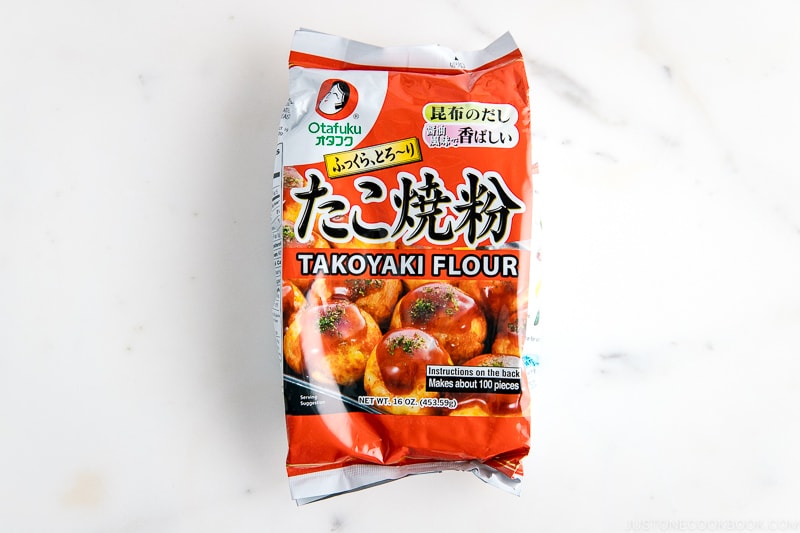
2. Octopus
You can purchase cooked (boiled) octopus (tako in Japanese) in Japanese grocery stores. If you are going to make this snack for a big party, you can purchase a whole cooked octopus at an online sashimi store like Catalina Offshore. When I buy a whole octopus, I use it for different dishes, including sashimi, carpaccio, octopus salad (Takosu), and of course, takoyaki.
3. Beni shoga (pickled red ginger)
Small bits of beni shoga (紅生姜), or red pickled ginger, give a nice pop on the color of takoyaki and a little spicy, pungent kick to the dish.
4. Green onion
The batter is yellow, octopus, and beni shoga are red… and now you need green color to make the dish look more appetizing (and delicious)!
5. Tenkasu or Agedama (Tempura scraps)
I often get questions about what Tenkasu does for the dish. We use tempura scraps for hot or cold Tanuki Udon Noodles and Okonomiyaki (even Hiroshima-style). The oil from Tenkasu adds richer and umami flavors, and additional crispness and creaminess inside takoyaki balls.
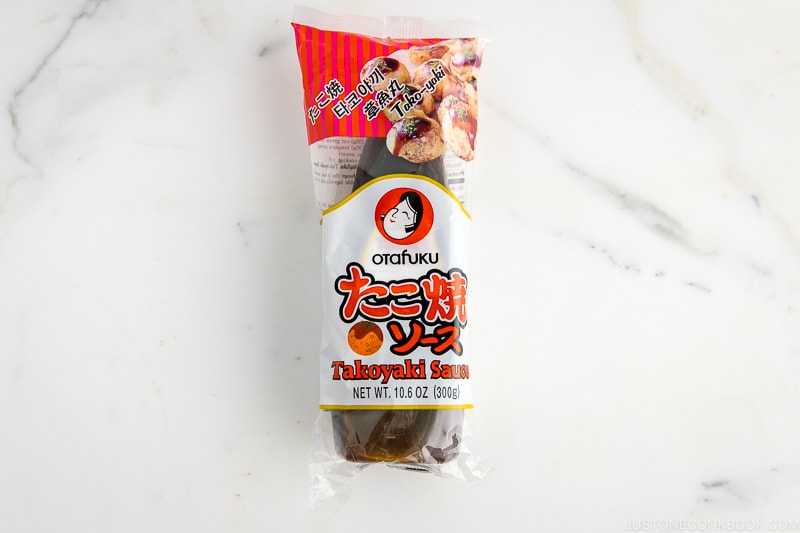
Takoyaki Sauce & Garnish
Takoyaki is served with Worcestershire sauce-like “takoyaki sauce”, followed by some squirt of Japanese mayo. You can:
- Buy a store-bought takoyaki sauce
- Make a quick homemade takoyaki sauce (recipe) with several condiments
Then it’s topped with a sprinkle of a few garnishes:
- Aonori (dried green seaweed)
- Katsuobushi (dried bonito flakes)
3 Tips to Make Perfect Takoyaki
I received many requests for this recipe from JOC Readers (thank you!). To make the recipe as authentic as possible, I asked my best friend Yukako who lives in Osaka. She makes delicious takoyaki at home and she and her husband shared their own recipe with me and JOC readers. Yay! I adapted the recipe a little bit so that some ingredients will be easier to measure.
Tip 1: Don’t be stingy with the oil.
Apply generous oil everywhere (each hole in the takoyaki pan and surrounding flat area). How generous? You should see 1/4 inch (5 mm) oil in each hole. The oil helps takoyaki to have crispy skin and it’ll be easier for you to flip without the batter being stuck.
Tip 2: Generously pour the batter.
When you see smoke coming out of the grill/plate, fill the hole with the batter. If it overflows, that’s okay. Because the entire grill top should be covered with the batter after adding octopus and other ingredients in the hole. If you use a bigger chunk of octopus pieces, you might want to pour just enough to the top of the holes. As soon as the octopus goes in, it overflows naturally.
Tip 3: Flip 90 degrees and stuff in the extra batter.
Break the extra batter around the hole with skewers. Once the bottom of the takoyaki balls is crispy, rotate 90 degrees to let the uncooked batter pour out into the hole. Stuff and push in the extra surrounding dough inside the balls. This will help make a perfectly round shape.
For a home takoyaki grill, each hole doesn’t provide the same amount of heat. Therefore, it’s important to switch around the balls once they are in a ball shape so they’re browned evenly.
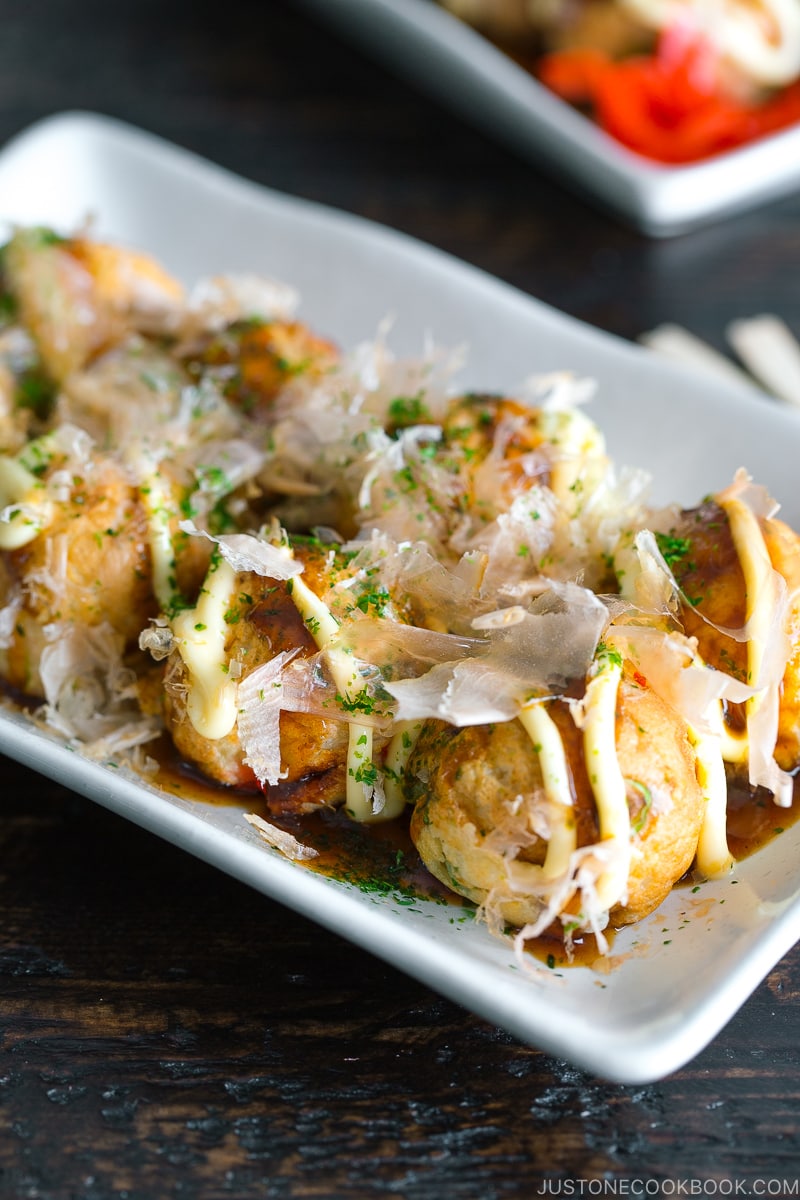
Don’t Like Octopus? Here Are Substitutions!
No problem! A lot of Japanese children enjoy different fillings besides pieces of octopus. Here are my suggestions for other fillings.
- Sausages / Bacon
- Canned tuna / Mentaiko (Spicy cod/pollock roe)
- Shrimp / Squid
- Cheese
- Mochi (rice cakes)
- Fish cake (chikuwa/crab sticks)
- Kimchi
- Corn
- Edamame
- Green peas
- Avocado
Various Takoyaki Grills
1. Zojirushi Gourmet Sizzler Electric Griddle + EA-YBC01 Takoyaki Plate (Optional) ($130 + $60)
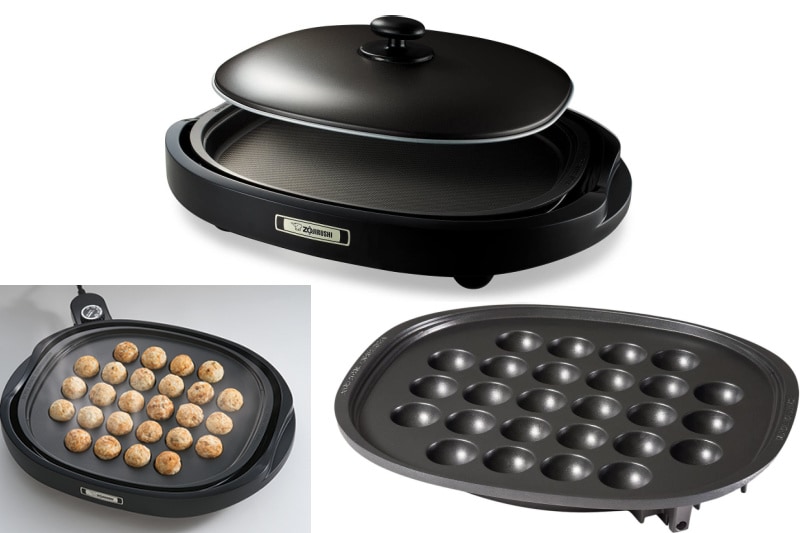
This is the takoyaki grill pan that I use. I use this electric griddle for Teppanyaki and Okonomiyaki. I switch the hot plate to the takoyaki plate when I make Takoyaki.
2. Iwatani Cassette Gas Takoyaki Device ($100)
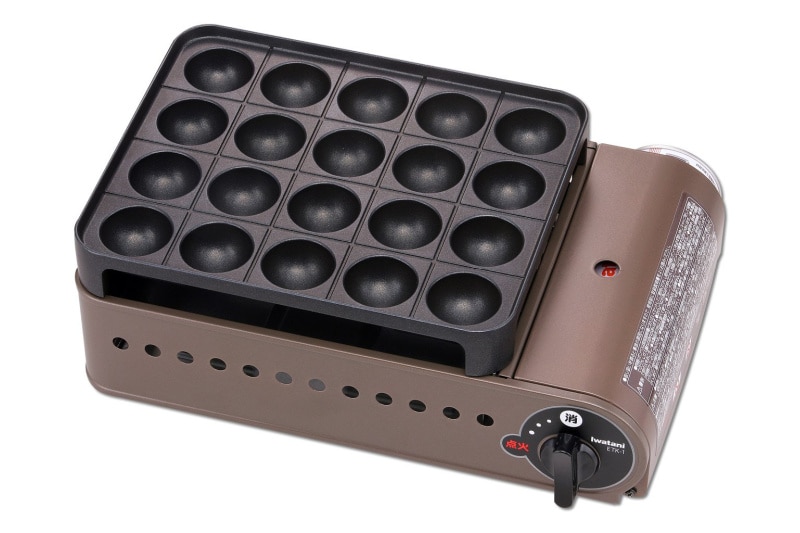
3. Iwatani Non-Stick Takoyaki Grill for Cassette Butane Stove ($40)
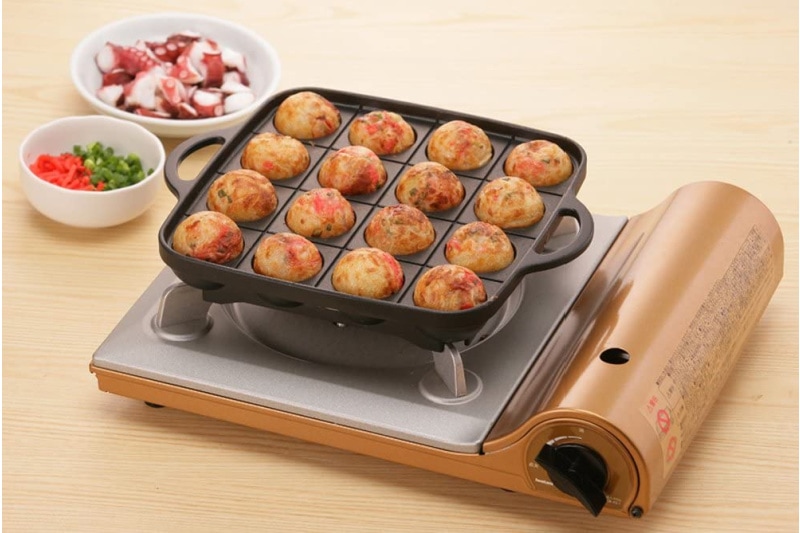
Do you have this Iwatani cassette feu butane stove already? I use this exact model for doing a hot pot at the table and sometimes filming my YouTube videos. If you have one already, then you can purchase this Iwatani accessory. The grill is non-stick and prevents food from sticking to the pan.
4. Yamazen Takoyaki Device ($45)
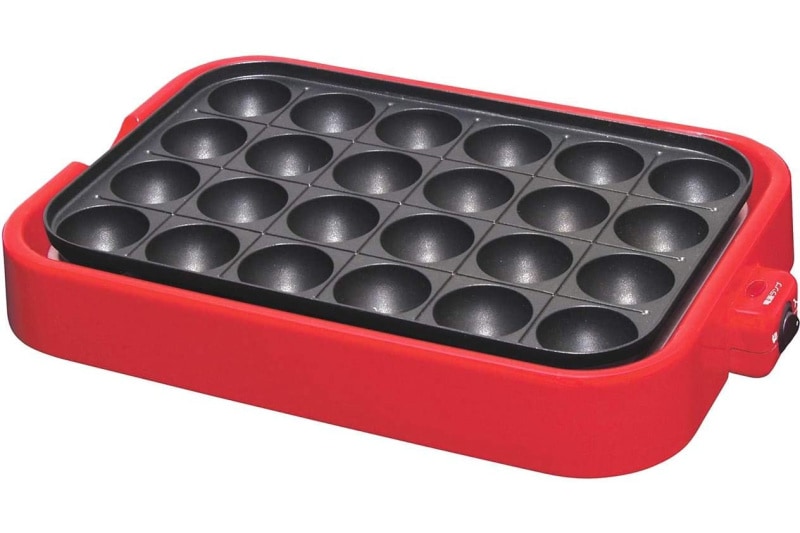
5. Ebelskiver (Danish) Pan ($25)
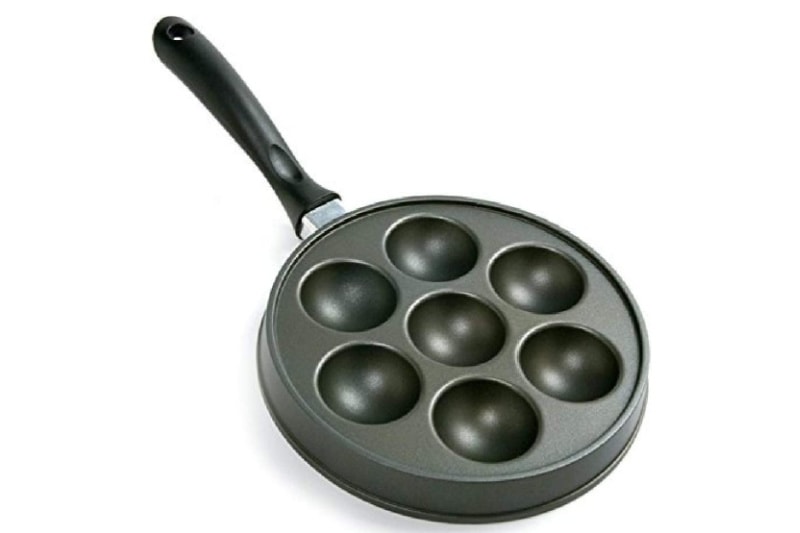
Many JOC readers told me they successfully made takoyaki with an Ebelskiver (Danish) pan or Appam Maker (Indian) as well.
Other Japanese Street Foods
- Yakisoba
- Okonomiyaki
- Taiyaki
- If you are interested in learning about Japanese Street Foods, check out Japanese Summer Festival Foods.
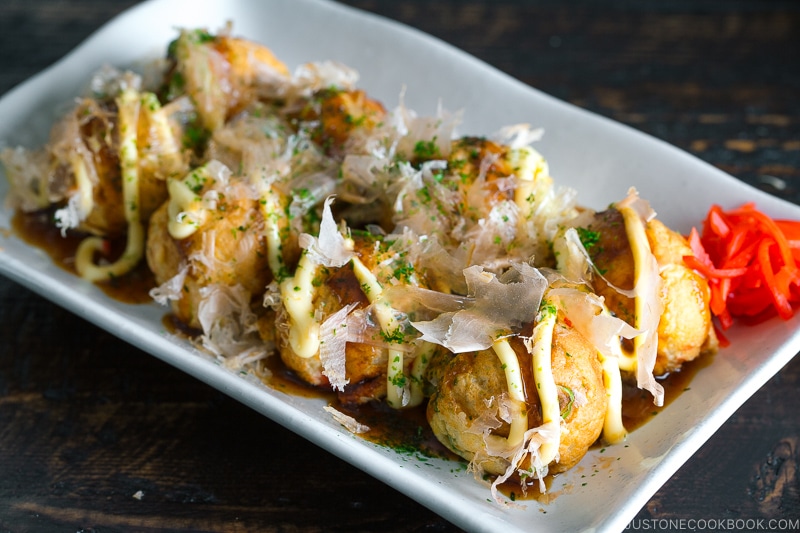
Wish to learn more about Japanese cooking? Sign up for our free newsletter to receive cooking tips & recipe updates! And stay in touch with me on Facebook, Pinterest, YouTube, and Instagram.
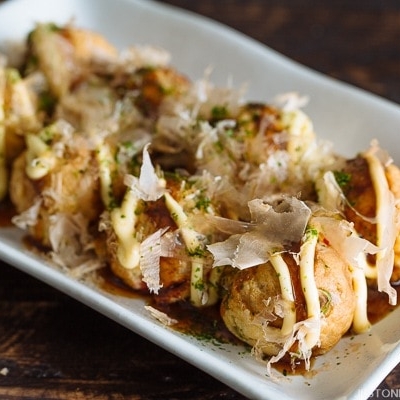
Takoyaki (Grilled Octopus Balls)
Video
Ingredients
- ¼ cup katsuobushi (dried bonito flakes) (I use the type with bigger flakes)
- 2 green onions/scallions
- 1 Tbsp pickled red ginger (beni shoga or kizami beni shoga)
- 4.2 oz octopus sashimi (boiled octopus) (found in Japanese grocery stores; or substitute with sausage, corn, edamame, cheese, small mochi pieces…the choices are endless!)
For the Batter
- 1 cup all-purpose flour (plain flour)
- 2 tsp baking powder
- ½ tsp Diamond Crystal kosher salt
- 2 large eggs (50 g each w/o shell)
- 1 tsp soy sauce
- 1½ cups dashi (Japanese soup stock) (use standard Awase Dashi, dashi packet or powder, or Vegan Dashi)
For Cooking
- 2 Tbsp neutral oil
- ⅓ cup tenkasu/agedama (tempura scraps)
Instructions
- Gather all the ingredients.

To Prepare the Filling
- Grind ¼ cup katsuobushi (dried bonito flakes) into a fine powder. Set aside; we‘ll use this powder when we‘re cooking the takoyaki.

- Cut 2 green onions/scallions into fine slices and mince 1 Tbsp pickled red ginger (beni shoga or kizami beni shoga).

- Cut 4.2 oz octopus sashimi (boiled octopus) into ½-inch (1.3-cm) bite-sized pieces; cut into smaller pieces for kids so they can chew it more easily. I use the rangiri cutting technique.

To Make the Batter
- In a large mixing bowl, combine 1 cup all-purpose flour (plain flour), 2 tsp baking powder, and ½ tsp Diamond Crystal kosher salt and whisk it all together.

- Add 2 large eggs (50 g each w/o shell), 1 tsp soy sauce, and 1½ cups dashi (Japanese soup stock).

- Whisk it all together until well blended and transfer the batter to a measuring cup with a handle (or any other pitcher with a spout for easy pouring.)

To Cook the Takoyaki
- Heat the takoyaki pan to 400ºF (200ºC) over medium heat. Use a brush to generously grease the pan‘s rounded chambers and flat top surface with 2 Tbsp neutral oil. When smoke starts to rise, pour the batter to fill the chambers. It’s okay to slightly overfill the cavities. In the next steps, the batter will likely overflow as you add more ingredients to it.

- Add 1–3 octopus pieces, depending on their size, to each chamber and sprinkle on top the katsuobushi powder that you ground earlier.

- Sprinkle ⅓ cup tenkasu/agedama (tempura scraps), the green onion slices, and the chopped pickled red ginger on top. After 3 minutes or so, when the batter on the bottom has set and is slightly crisp, use skewers to break the connected batter between each chamber. Then, rotate each piece 90 degrees (a quarter turn) toward the bottom of the pan, stuffing the connected dough back into the ball as you turn it. The uncooked batter will flow out from inside to create another side of the ball. After you finish turning them, set a timer for 4 minutes.

- After 4 minutes, rotate them again, starting with the first ball: Turn each takoyaki another 90 degrees toward the bottom of the pan so the remaining uncooked batter pours out into the chamber to complete the ball shape. Home takoyaki griddles don‘t distribute heat evenly, so it’s a good idea to swap the balls around to different chambers so they brown evenly. After turning and cooking for another 4 minutes, they are done.

To Serve
- Transfer them onto a plate and drizzle ½ cup takoyaki sauce and Japanese Kewpie mayonnaise on top. Finish the dish with a sprinkling of katsuobushi (dried bonito flakes) and aonori (dried green laver seaweed) and a side of pickled red ginger (beni shoga or kizami beni shoga). Serve immediately. (But, be careful—they‘re VERY hot inside!)

To Store
- You can keep the leftovers in an airtight container and store in the refrigerator for 3 days or in the freezer for 2–3 weeks.
Nutrition
Editor’s Note: The post was originally published on Oct 20, 2013.
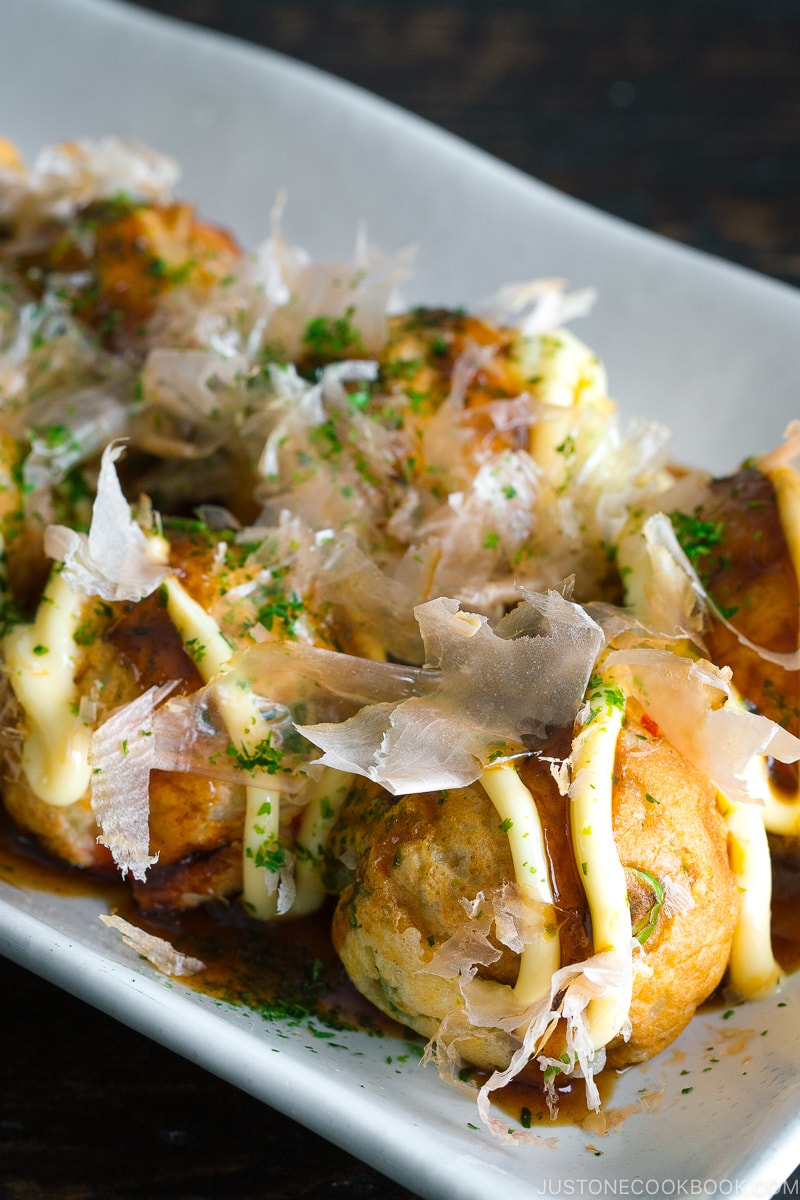
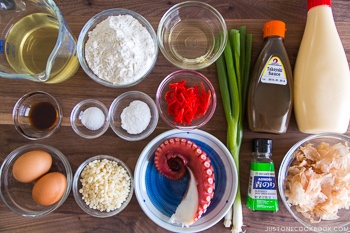
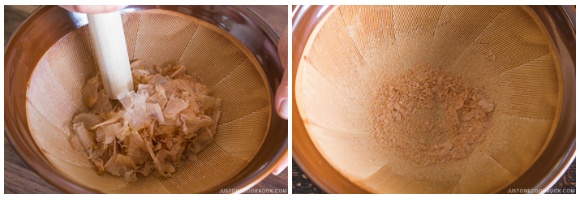
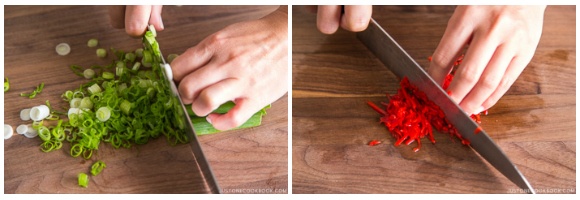
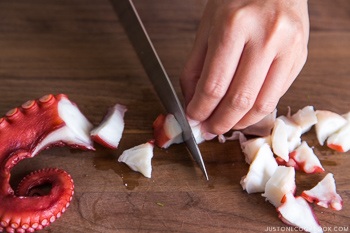
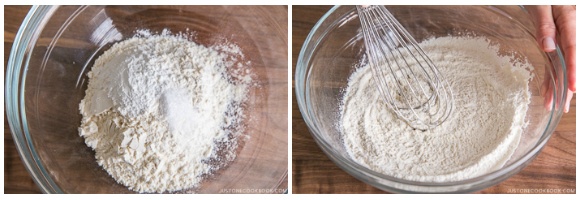
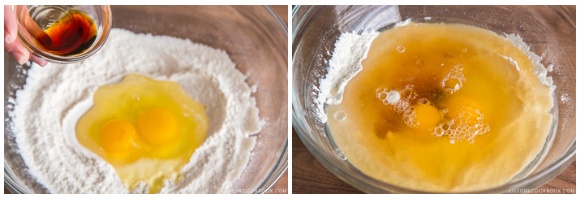
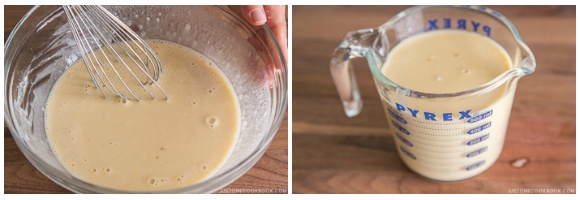
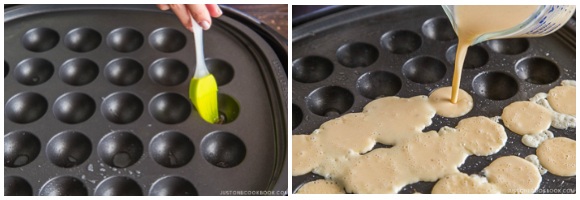
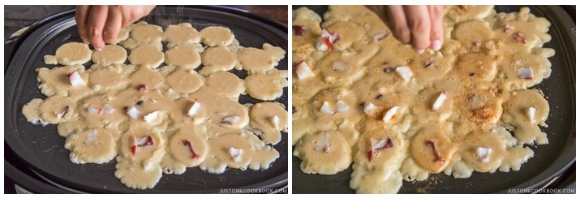
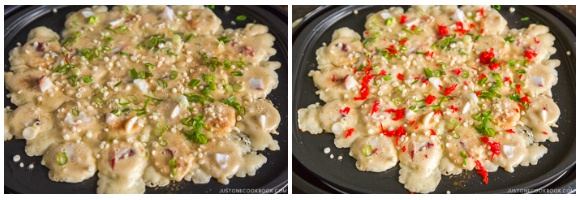
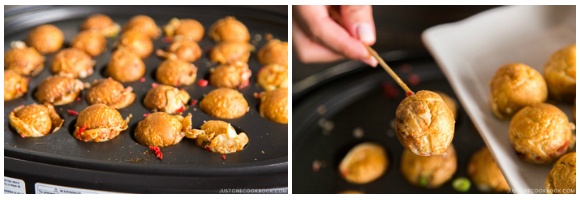











Hi there. Thank you for this thorough recipe! For mochi, what kind of mochi is typically use? I keep kiri mochi blocks on hand for yakitori.
Hi Meli! Thank you for reading Nami’s post and trying her recipe!
Yes! Kiri Mochi works great. You can cut it into small cubes and add them.
We hope this helps!
Thank you for sharing your recipe! My son and I just enjoyed a nice time together figuring this out and it was very tasty. It was fun to turn each ball. It looks like such a disaster and then poof it’s tidy. Very fun and delicious.
Hi Jill! Thank you for trying Nami’s recipe and sharing your cooking experience with us!
We are so happy to hear you and your son enjoyed making Takoyaki!
Happy Cooking! 💞
Hi! Do I have to cook octopus before using it? I bought itittle octopus fresh frozen. Or is it enough to cut them in smaller pieces and they will be cooked with takoyaki? They don’t need to be cooked long, right? I’m cooking octopus for the first time.
Hi Svetlana, Thank you very much for trying Nami’s recipe!
If the octopus is fresh, please boil it first for this recipe, and cut it into small bite pieces for this recipe.
We hope this helps!
Which type of dashi is best for making Takoyaki?
Hi Victor, Thank you very much for reading Nami’s post and trying her recipe!
Any type of Dashi would work, but Nami used Awase dashi.
We hope this helps!
Thank you will love to try your takoyaki recipe. Will need to buy the pan first
Hi Daisy! Thank you for reading Nami’s post!
We hope you enjoy making and tasting Takoyaki soon.😃
Hmm it might just be that my pan is smaller but I got much more than 24 out of it? My first batch came out way too salty and I find them easier to turn if I don’t over stuff the filling. Thank you for posting this recipe though . I’m substituting a lot of ingredients because I’m allergic to fish but the Batter recipe seems to work really well with chicken stock instead of daishi. Thank you.
Hi Taco, We are glad to hear you enjoyed the Takoyaki recipe.
The Takoyaki pan has slightly different pan sizes, so your pan is probably a smaller one.
Thank you for trying and sharing your cooking experience with us!
Hi! Has anyone tried to make this in a waffle iron? I am dying for some takoyaki but my tiny kitchen prevents me from buying another one-use type of device. Please let me know if it would be possible. Many thanks, L. Xx
This recipe was fantastic, very happy with the result. Just need to practice more the turning so they are more rounded 😊
Hi Marcela, We are glad to hear you enjoyed the Takoyaki recipe!
Thank you very much for your kind feedback.☺️
It turned out amazing <3 but how do you recommend heating them after freezing?
Hi Yaara, Thank you very much for trying this recipe! We recommend reheating in the microwave until the inside gets warm.
I had takoyaki for the first time in Bordeaux a couple of years ago, they were absolutely fantastic and I tried them in several asian restaurants but they were never good as the first ones I had. Well…this recipe finally made my dreams came true. It’s stunning: tasty, well balanced, not too salty and with the right texture. I bought a takoyaki pan and used it for the first time in my life with this recipe, the batter was simply perfect and it was sooo simple and satisfying. Thank you!
Hi Francesca, Yay!🤩 We are glad to hear this recipe worked out great for your new Takoyaki Pan! Thank you very much for trying this recipe and for your kind feedback! Happy Cooking!
I got a takoyaki pan for Christmas, and it fits perfectly over my portable butane stove. Thank you so much for the detailed recipe – I’m enjoying my very first batch of homemade takoyaki right now! Making the nice round shape was challenging, but so satisfying. 🙂
Hi Willa,
Wow, That is a nice Christmas gift!
To make a nice round shape, pour the batter a little more to overflow the holes at Step 1 and tucked in the extra batter when you turn the Takoyaki at Step 4.
We hope this is helpful! Thank you for trying this recipe!🙂
Great recipe. Once we make the batter, if we put in sealed container and use when needed in restaurant, how long will batter last for in fridge?
Hi Tommy, Thank you very much for your kind feedback! The batter can be stored up to the next day in the fridge. We hope this helps!
Hi Nami!
I received a takoyaki cooker for Christmas and am excited to try your recipe! I was going to use bacon instead of octopus, should I cook it first?
Thanks for the help!
I hope you and your family are having a safe and healthy holiday!
Hope
Hi Hope!
Wow! That is a nice Christmas gift!🎁
To make bacon Takoyaki, we recommend cooking chopped bacon on the Takoyaki maker to be flavourful. It also leaves some oil on the takoyaki maker, so you can skip using the oil. Then you can add the Takoyaki batter to it and continue to step 3. But it’s totally up to your preference.
I like adding cheese to it too. It will be appetizing.😁
Have a wonderful Holiday and New Year!
This article made me so hungry!
Hi Martha!
Thank you!
We hope you can try this recipe one day.🙂
You know when you get excited and go a little too hard? Loved the pictures, but wish it told me the difference between dashi paste i got from the market and dashi broth instead of just calling it dashi… gonna save the goop in my bowl like partially started takoyaki mix and add water, egg, and flour until it looks like it should. Yay future takoyaki mix at least?
Hi Jude! I’m sorry that you misunderstood my recipe. I’ve never heard of “dashi paste”. I’m aware of dashi powder or dashi packet/sachet as a product but nothing in “paste” form… Could you share the picture with me (email me) or let me know the brand name? “Dashi” is always a liquid form. It’s not a solid thing.
I mentioned in the recipe: 1 ½ cup dashi (click to learn more about this soup stock) (360 ml)
It’s the soup stock, not paste or powder. I also have ingredients and step by step images and the video tutorial. Please read the recipe carefully to save from making mistakes. I’m always checking comments and emails to help you with any question you have. 🙂
Thanks for the recipe! I made it last night and it was delicious.
One question:
When mixing the dry ingredients, do the ground bonito flakes go into the batter? The instructions are not real clear because step 5 starts with “Add flour…” As in “add flour to the flakes you just ground up” or “New, unrelated step: add the following ingredients together.”
If the bonito powder is not meant to be mixed with the dry ingredients, I recommend re-wording step 5 to avoid confusion. Maybe at the end of step 4 say “set aside.” Then start step 5 with “Mix the following together” instead of starting with the word “add.”
I mixed it in when I made it last night and it was still good. But I was reading the recipe again this morning and realized it could go either way.
Thanks again for the recipe. I’m making more today!
Hi Jermjerm! I’m so glad to hear you enjoyed the recipe. Sorry about the confusing English. I fixed it. 🙂